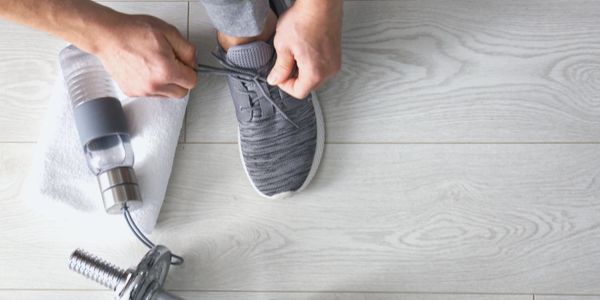
What is the deal with Tabata? Although it sort of sounds like the name of an exotic meal, Tabata workouts are some of the most popular among fitness enthusiasts. Their somewhat astounding results have beginners to veterans incorporating Tabata exercises into regimens. Learn all you need to know about Tabata including a full-body Tabata workout and more.
What Is a Tabata Workout?
Coined by Japanese physician Dr. Izumi Tabata in the late 1990s, Tabata is similar to or a form of high-intensity interval training (HIIT). Tabata raged like a summer storm when research showed that people performing this type of exercise burned 15 calories per minute and improved both their aerobic and anaerobic fitness levels.
The best part? These participants simply completed eight rounds of 20 seconds of work followed by 10 seconds of rest (a total of four minutes) five times a week! (No longer did endless jogging warrant necessity!)
Instead, 20 minutes was the recommended amount of time to fit in a Tabata workout. Since one round of Tabata lasts four minutes, this means one could theoretically complete five different exercises of variations of movement during a 20 minute period. Nowadays, there are Tabata timers on phone applications that help someone keep track of their intervals.
Tabata Exercises & Styles
Now, Tabata can be used for just about any style of exercise or within any type of cardio. They can be completed using bodyweight movements, dumbbells or kettlebells, on a stationary bike, while running, jump roping, and so much more.
Generally, Tabata workouts are very intense because of the intent to do the exercise as hard as possible for 20 seconds followed by a super short rest period. For reference, typical HIIT workouts require an exercise to be completed at max capacity for 4-20 seconds followed by 40-120 second rest periods.
Benefits of Tabata Workouts
Compared to the American Heart Association's recommendation to achieve 30 to 60 minutes of physical activity most days of the week, Tabata does not quite fit the book. Yet, despite this, many individuals see substantial results doing Tabata-style workouts for as little as 10-20 minutes a few days of the week? How can someone spend minimal time maximizing muscular and cardiovascular benefits?
Similar to resistance training, but to a much larger extent, HIIT workouts enhance exercise post oxygen consumption (EPOC), also known as oxygen debt. This term refers to how much oxygen the body requires to restore the body to its normal, resting metabolic rate, which also happens to demand plenty of calories. Meaning, the body is burning more calories than usual well after exercise is completed.
Is there a way to enhance EPOC? Certainly!
Unsurprisingly, HIIT workouts optimize EPOC most. Quick, powerful movements that use multiple large muscle groups create a large demand for ATP from anaerobic (without oxygen) pathways. In turn, this creates a large demand on the aerobic (in the presence of oxygen) pathways to replenish the ATP during rest periods and post-exercise recovery process.
All-in-all, HIIT workouts, including Tabata, optimize EPOC and caloric burn because they use a lot of energy for the intense exercises during the workout and then use even more energy to replenish muscle glycogen and rebuild muscle proteins after completed.
The general benefits of Tabata workouts include:
• Time-efficiency
• Boosts metabolism
• Burns substantial calories during and after completion
• Increases and/or tones lean muscle mass
• Boosts aerobic and anaerobic fitness levels
• Raises heart rate substantially
• May decrease blood pressure and cholesterol levels
• Promotes more weight loss
• Reduces abdominal and body fat
• Improves strength
• May improve insulin sensitivity
Potential Risks of Tabata
Doing any type of HIIT poses some risk.
Because of the intense nature of these workouts, an increased injury rate is a major risk. When exercise intensifies, people focus less on proper form, and therefore, the injury rate increases.
In addition, Tabata tends to be a pretty advanced exercise method, so beginners may find it too difficult at first. To combat this, modify the work to a rest period (i.e. 20 seconds of work followed by 20-40 seconds of rest) and progress to the normal Tabata training intervals as stamina, endurance, power, and strength increase.
Less of an overt risk and more of a pitfall, some people do not find Tabata very pleasant because of the severely short rest periods. Thus, some people do not stick to it and then get frustrated about the lack of results.
But when it comes to exercise, it is much better to engage in joyful movement that is sustainable than to force exercise in an unenjoyable manner. The latter will not last long.
Tabata Workout Examples
If Tabata workouts sound appealing, try any one of the following!
The general flow of each workout is 20 seconds of intense work, followed by 10 seconds of rest. This is completed two times every minute, for a total of eight rounds in four minutes.
For some workouts, one exercise will be completed eight times within the four-minute block. Other workouts will alternate two exercises so that each is performed four times within the four-minute block.
The total recommended time for each workout and any other specific information will be listed at the top under each workout title.
Full-Body Tabata Workout
Total time: 20 minutes
Block 1 (4 minutes)
• Air squats
Block 2 (4 minutes of alternating between the two exercises)
• Jumping jacks
• Jump squats
Block 3 (4 minutes)
• Inchworm pushups
Block 4 (4 minutes of alternating between the two exercises)
• Shoulder push-ups
• Plank hold
Block 5 (4 minutes)
• Reverse lunges
Tabata Abs Workout
Total Time: 20 minutes
Block 1 (4 minutes)
• Plank hold
Block 2 (4 minutes of alternating between the two exercises)
• Scissor kicks
• Bicycles
Block 3 (4 minutes of alternating between the two exercises)
• Side plank hold
• Opposite side plank hold
Block 4 (4 minutes)
• Penguin heel touches
Block 5 (4 minutes of alternating between the two exercises)
• Cat-cows
• High knees
Running Tabata Workout
Total Time: variable
(Modify the warm-up and cool down to be as long as necessary for training/competition goals.)
Block 1
• Warm-up at light to moderate pace for 5-20 minutes
Block 2 (4 minutes)
• Jog at 85% capacity
Block 3 (4 minutes)
• Sprint at max capacity
Block 4 (4 minutes)
• Jog at 80% capacity
Block 5
• Cool down at light to moderate pace for 5-20 minutes
Leg Strength Training Leg Tabata Workout
Total Time: 16 minutes
*Add this into a full workout or complete on its own
Block 1 (4 minutes)
• Weighted squats (about 75-80% of normal weight)
Block 2 (4 minutes)
• Deadlifts
Block 3 (4 minutes)
• Leg presses
Block 4 (4 minutes of alternating between the two exercises)
• Burpees
• Jump squats (hold weight for additional intensity/to make harder)
Exercise Machine Tabata Workout
Total time: 20 minutes
*Example based on a treadmill, but bike, elliptical, stair stepper, etc. can also be used by increasing resistance and/or cadence/pace during each block, respectively.
Block 1
• Warm-up at light to moderate pace for 5-20 minutes
Block 2 (4 minutes)
• Sprint at 80-90% capacity
Block 3 (4 minutes)
• Increase incline to 12-15% grade if walking or 7-10% if jogging/running
Block 4 (4 minutes)
• Walk backward at 75-80% capacity (add 3-7% grade incline to increase the intensity/make harder)
Block 5 (4 minutes of alternating between the two exercises)
• Sprint at 85% capacity
• Increase incline to 15% grade if walking, or 5-10% grade if jogging/running
10 Tabata Tips
To get the most out of Tabata workouts, use these top 10 tips to get started and throughout all training sessions:
1. Ease into Tabata at your own pace and modify if needed at first.
2. Only do Tabata or HIIT workouts every other day at most.
3. Use a guided Tabata timer to avoid having to look at a stopwatch so often.
4. Alternate between strength and endurance-based Tabata workouts for best results.
5. Add a Tabata burnout (1 to 3 rounds) at the end of a normal workout for an extra challenge.
6. Utilize powerful movements like burpees or jump squats in some Tabata workouts.
7. Use lighter-than-usual weights during strength-based Tabata workouts.
8. Avoid doing Tabata workouts longer than 30 minutes as the intended intensity will be compromised.
9. Focus on the proper form of exercises before optimizing speed.
10. Have fun and only do Tabata exercises if they are enjoyable!
The Tabata Takeaway
Tabata is a type of HIIT workout that utilizes 20 seconds of work followed by 10 seconds of rest for four minutes or eight total rounds. There are many variations of Tabata and the technique can be used in nearly all types of exercise from strength training to plyometrics to sprinting and cycling.
While it boasts many benefits like improved aerobic and anaerobic fitness, perhaps its biggest allure is its efficiency. All one needs is 8 to 20 minutes to achieve an effective workout with Tabata.
Best of all, its intense nature boosts EPOC, which naturally burns more calories long after exercise ends. It is one of the best healthy weight maintenance techniques available.
So, next time a workout beckons, try Tabata!
References:
Cronkleton E. Tabata vs. HIIT: How These Workouts Differ. Healthline. Published July 9, 2020. www.healthline.com/health/exercise-fitness/tabata-vs-hiit.
McCall P. 7 Things to Know About Excess Post-Exercise Oxygen Consumption (EPOC). ACE Fitness. Published August 28, 2014. www.acefitness.org/education-and-resources/professional/expert-articles/5008/7-things-to-know-about-excess-post-exercise-oxygen-consumption-epoc/.







